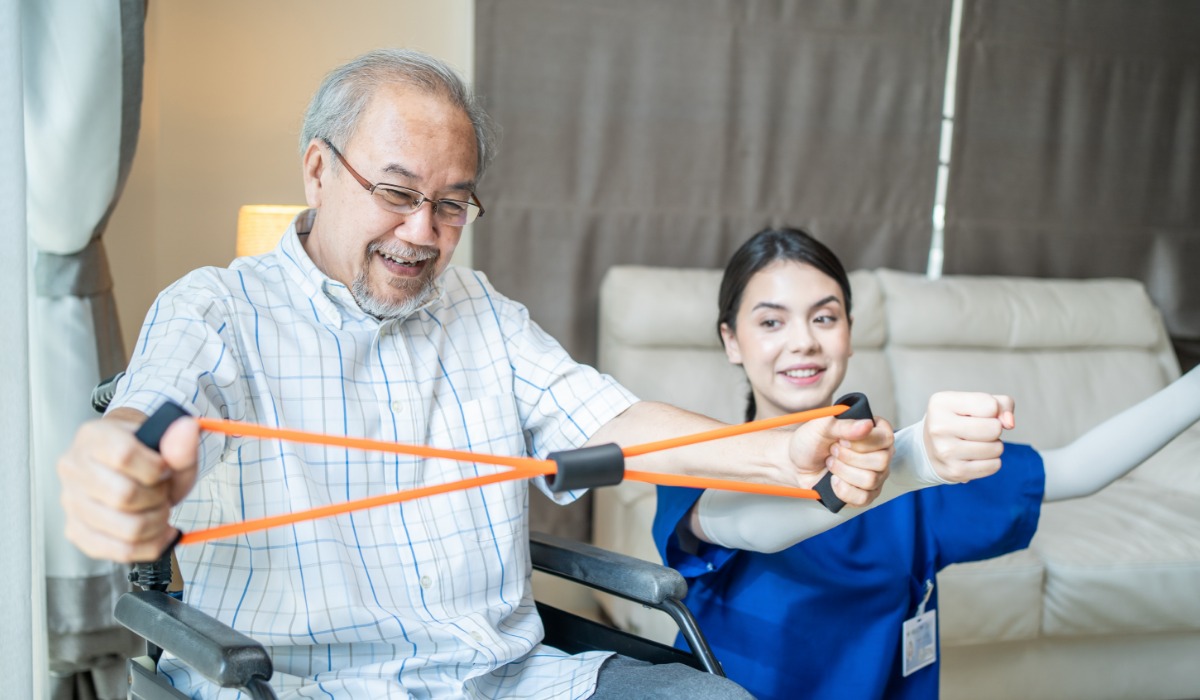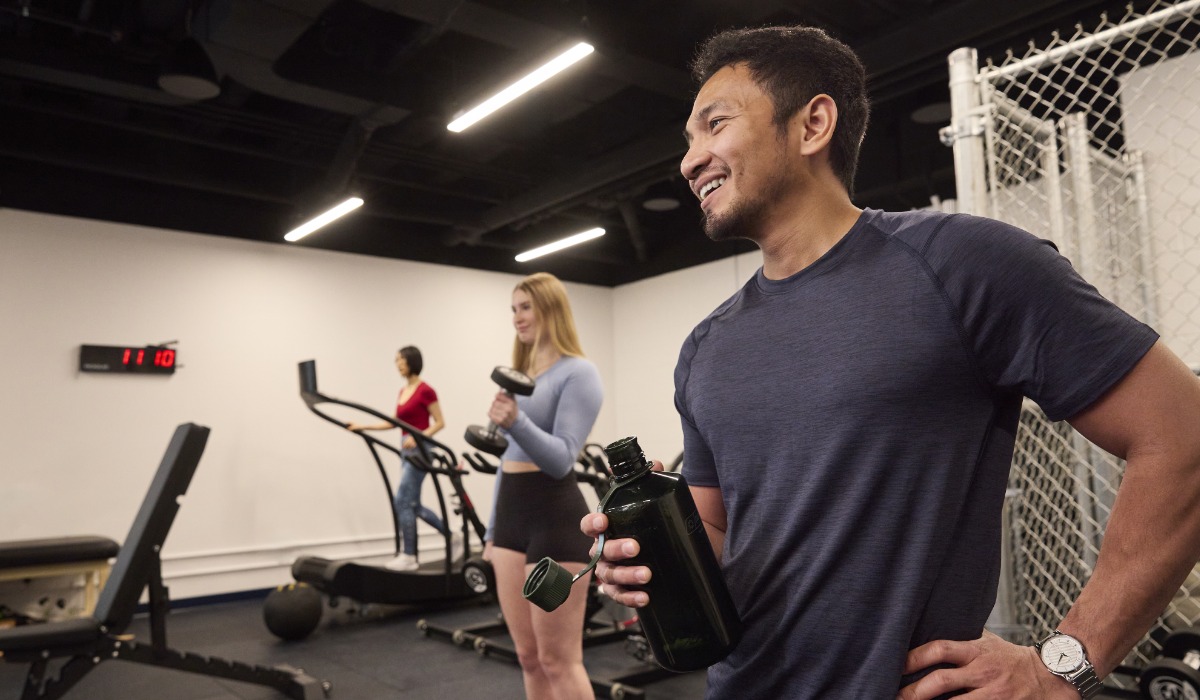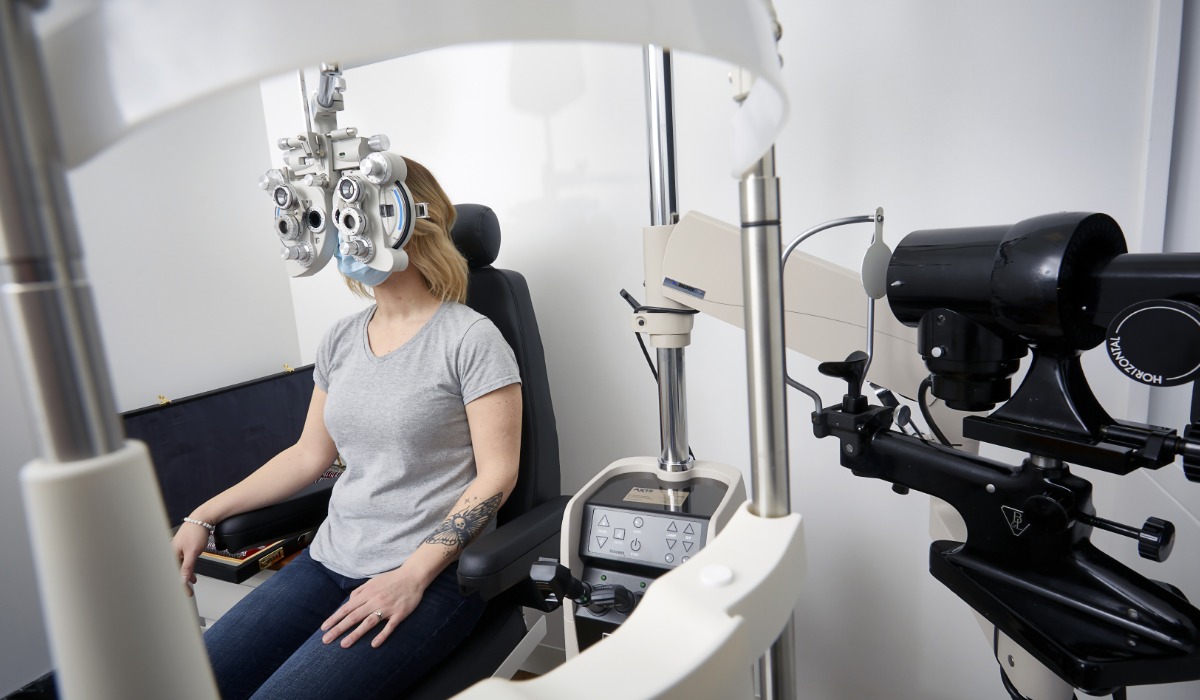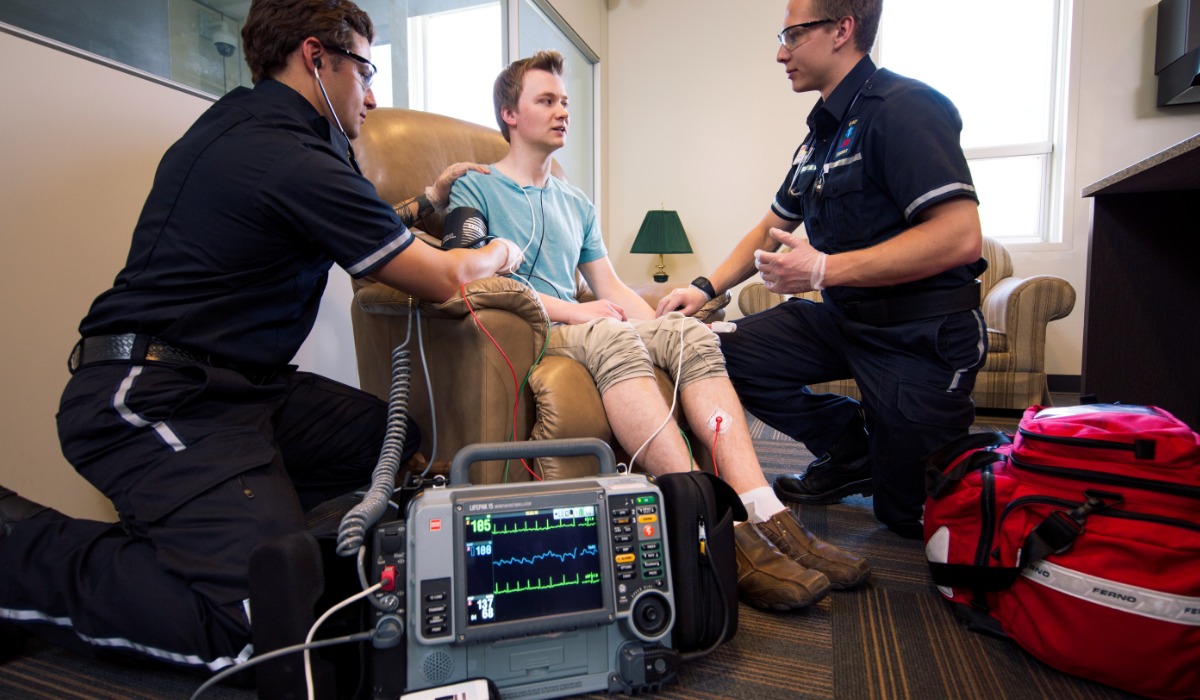Program update
Effective as of intakes in the 2026-2027 academic year, this program will be titled Occupational/Physical Therapist Assistant.
Overview
Our Rehabilitation Therapy Assistant program provides comprehensive training for those who seek to support individuals with disabilities and functional impairments. As medical advancements break down accessibility barriers, the demand for skilled therapy assistants grows.
In this program, you will:
- learn under the guidance of experienced occupational therapists and physiotherapists
- acquire essential competencies that exceed the national standards for occupational therapy and physiotherapy assistants
- learn core rehabilitation and healthcare delivery concepts and skills
- participate in observational clinical visits to witness the practical application of therapeutic skills
- study advanced rehabilitation concepts, common health conditions, and therapeutic methods
- develop a deep understanding of complex health conditions and advanced therapeutic techniques
- complete practicum rotations to apply and refine your skills in real-world settings
We'll equip you with the theoretical knowledge and practical skills to ensure you can make a meaningful difference in the lives of those requiring rehabilitation therapy.
As a graduate, you will be prepared for occupational therapist or physical therapist assistant roles. You will effectively manage therapeutic supplies and equipment within healthcare facilities and help your clients improve their quality of life.
Those in rehabilitation therapy tend to be methodical, social and objective.
You need:
- empathy
- patience
- the ability to work well under stress, maintain professional behaviour and regulate your emotions
- flexibility
- effective communication skills
- interpersonal skills
- organizational skills and attention to detail
- physical strength and stamina, including the ability to use your hands, wrists and arms for prolonged periods
- manual dexterity
- the ability to encourage patient confidence and participation
- the ability to work independently and as part of a team.
You may need to wear personal protective equipment (PPE) for long periods, which includes exposure to latex and disinfection materials. You must be comfortable performing patient care procedures in very close proximity to your clients.
Some positions will require extended work hours and shift work, including nights and weekends.i
You are strongly encouraged to refer to the ALIS website for career, learning, and employment information for occupational therapy assistants and physical therapy assistants to ensure you can successfully meet the occupational requirements for the program and profession.
You'll complete required practicum rotations in a clinical facility where you will work under the supervision of a licensed physiotherapist or occupational therapist.
You will be assigned practicum placements with consideration given to your preference of location. However, due to limited availability in Calgary, it might be necessary for you to travel or relocate outside the of the city or province.
The healthcare field has a strong focus on health, wellness, and fitness to practice due to the demanding nature of the work and Occupational Health and Safety requirements. As such, special considerations will not be granted based on individual circumstances or preferences, except those stated as protected grounds when an accommodation has been approved.
In compliance with the practica agreements with our clinical partners, you will be required to provide specific documentation before you can participate in your practicum. Find out what requirements you need for this program.
International students must also complete their Immigration Medical Exam (IME) and obtain a co-op work permit to attend this practicum. For more information, please contact the International Centre.
This program is accredited by the Occupational Therapist Assistant and Physiotherapist Assistant Education Accreditation Program in collaboration with Physiotherapy Education Accreditation Canada (PEAC) and the Canadian Association of Occupational Therapists (CAOT).
Graduates will earn their Occupational Therapist Assistant (OTA) and Physical Therapist Assistant (PTA) designations.
Upon successful completion of this program, you'll be awarded a SAIT Rehabilitation Therapy Assistant diploma.
Careers and opportunities
Each year, SAIT conducts a survey between February and April to determine the employment rate, salary and satisfaction of our newest SAIT alumni.
![]() 93% graduate employment rate
93% graduate employment rate
![]() $48,000 average starting salary
$48,000 average starting salary
Find out more about our graduate employment statistics >
Our graduates may work in the following occupations. Some careers require additional experience and education.
Associated National Occupational Classification (NOC) codes: 31203, 31204, 31209, 33109, 32109, 33102.
Career planning support
Unsure which career path is for you? Here are some recommended career planning resources to help you decide your future.
You can also head to Alberta alis for lots of information about careers in Alberta, including quizzes and labour market information to help you narrow down a path.
Finally, you can take our online career finder quiz, which can help narrow your options based on your current skills and interests.
Courses
The Rehabilitation Therapy Assistant diploma requires 60 credits (22 courses) to complete.
The program spans two years, with three semesters in year one, and two semesters in year two.
| Course | Credits |
|---|---|
|
This course provides an overview of the basic anatomy and physiology of the human body. While focusing on the functions, structures and processes of the different body systems you will learn about anatomical positions, cells, muscle fibers, bones and joints, the spinal cord, sensory receptors, hormones, the major organs and digestion. Other topics covered in this course include healing, immunity, aging, the body's adaptive responses to sickness and disease, the menstrual cycle, and reproduction. |
3 |
|
Effective interpersonal communication skills are essential in the healthcare field in order to establish effective relationships with clients, families and other health-care professionals. In this course, developing an awareness of personal communication style and skills is coupled with respect for others and an awareness of cultural diversity in learning how to maintain professional boundaries. The development of active listening, interviewing, verbal and non-verbal communication skills and conflict management skills is achieved through role-playing in simulated clinical situations. Pre-requisites:
|
3 |
|
This course examines the conceptual framework that supports the practice of rehabilitation and the specific roles of the rehabilitation therapist assistant within this framework. Areas explored include rehabilitation team members, ethical and professional behaviour, therapeutic relationships, and effective delivery of rehabilitation services. Clinical documentation practice is introduced as a foundational skill that will be built upon throughout the program. These conceptual and practical foundations are reinforced by a series of observational visits to selected clinical settings which will serve as a basis for successful clinical fieldwork and professional employment upon graduation. |
3 |
|
This course involves a practicum placement in a clinical facility as well as a short classroom component. Reflective learning tasks are used to reinforce concepts during and after the placement through online discussion board participation. Under the supervision of a licensed physiotherapist or occupational therapist, the learner will apply both theoretical knowledge and practical skills in the clinical environment. Pre-requisites:
|
3 |
|
Practicum 2 provides the learner with an opportunity to integrate both theoretical knowledge and practical skills in a clinical setting. Demonstration of entry-level occupational therapist assistant and physiotherapist assistant skills will be required. Pre-requisites:
Corequsites:
|
6 |
|
As future healthcare professionals, learners in this course will explore strategies for working effectively, professionally, and respectfully within interprofessional teams, to ensure high quality delivery of healthcare services. Time will be spent exploring how personal power and privilege must be considered when working with diverse cultures in the healthcare environment. Impacts of global, national, and local perspectives of healthcare on the delivery of rehabilitation services in Alberta are also examined. |
1.5 |
|
In this course, reflective learning tasks are used to reinforce concepts before, during, and after practicum rotations. Students will apply ethical practice, reflection, and critical thinking, in their role as occupational therapist assistants and/or physiotherapist assistants. Students will also learn skills relevant to seeking employment upon graduation. Corequsites:
|
3 |
|
In Lifespan Development, all stages of normal human development from conception to death are studied from a developmental psychological perspective with a focus on human behaviour and cognitive, social and personality development. Identifying the prenatal, family and environmental influences on developmental psychology and the use of developmental psychological concepts and theories in the application of rehabilitation are also addressed. Personal experiences and observations by the learners are incorporated to help identify the different concepts and stages in developmental psychology. |
3 |
|
This course provides learners with opportunities to further develop and practice safe client-centered care. Skills-based elements such as wheelchair fitting and maintenance, sewing adaptation, gait analysis, ambulation with gait aids, and client instruction will be covered. Pre-requisites:
Corequsites:
|
1.5 |
|
Building on previous learning, this course focuses on a variety of health conditions commonly treated by rehabilitation interventions. These range from neurological, cardiovascular, and respiratory conditions, to health conditions involving multiple body systems. The spectrum of intervention types are related to the functional impairments associated with the health conditions. Pre-requisites:
|
1.5 |
|
Identifying and describing the medical terminology, structure and function of the key body systems involved in human movement is essential in the practice of rehabilitation therapy. Anatomy of Movement is an introductory course on functional movement with emphasis placed on describing and analyzing the functionality of the skeletal, muscular and peripheral nervous systems including gross movements and surface anatomy. Learners develop observational and client handling skills through hands-on experience by palpating and moving the structures of the body to gain an appreciation of the three-dimensional nature of the body and its movement potential. |
3 |
|
in this course, safe client-handling techniques and effective verbal and non-verbal communication skills are developed through the integration of theory and practice emphasizing the principles of client-centered care. In the laboratory, safe practices and infection control measures are applied to all activities including the safe lifting, transferring and positioning of clients, using wheelchairs and conducting range of motion exercises. Biomechanical principles in rehabilitation and client monitoring practices are also examined in order to promote safe client contact in the workplace. |
3 |
|
In this course, the many uses and applications of therapeutic modalities in rehabilitation and client-centered care are practiced in a lab setting as learners focus on the healing process, the physical agents affecting or impeding healing, and the client's response to treatment. Learners will draw on their knowledge of anatomy, physiology, and pathology while studying the rationale for selecting and using different modalities, including electrical stimulation, mechanical traction, ultrasound, and the use of hot and cold packs. Pre-requisites:
|
3 |
|
This course explores core concepts and principles that provide the occupational therapy assistant (OTA) with a solid foundation in the history, theory, and basic clinical skills required for providing client-centred care. The relationship between a client's cognitive, visual, sensory or perceptual impairment is examined in relation to three important occupational performance areas: self care, leisure and productivity/work. Activity analysis, grading, environmental assessment techniques and teaching and learning styles are emphasized in developing and implementing occupational therapy interventions to help clients live independently. Pre-requisites:
Corequsites:
|
3 |
|
Therapeutic exercise is the most common intervention used in rehabilitation practice. In this course, anatomical knowledge and exercise theories are integrated to provide the rationale for various exercise techniques. Through the use of scenarios, learners will develop the skills necessary to apply and modify exercise techniques safely to meet the needs of clients in response to changes in physical status, or based on direction by the supervising therapist. Pre-requisites:
|
3 |
|
In this course, the benefits of rehabilitation intervention are examined by focusing on a variety of health conditions commonly treated by rehabilitation ranging from soft tissue injuries, bone and joint problems, and strokes, to pain syndromes. Using case studies, learners research these health conditions and identify how impairment in body function and structure can limit and restrict a client's ability to perform simple tasks or participate in everyday activities. The emphasis is on understanding medical, surgical and rehabilitation management of these conditions and applying that knowledge to optimize client outcomes with the parameters of the role of the occupational therapy assistant and the physical therapy assistant. Pre-requisites:
Corequsites:
|
3 |
|
In this course, the core principles, concepts, and processes of occupational therapy are applied to clients with mental health issues. The occupational therapist assistant (OTA) applies knowledge of psychiatric diagnoses and treatment models to interventions, to promote occupational performance and improve independence while providing client-centred care. Pre-requisites:
|
3 |
|
In Occupational Therapy Assistant Advanced Practice Skills the core concepts, principles and processes of occupational therapy are applied to clients with cognitive, neuromuscular and musculoskeletal conditions. Splinting, use of adaptations, activity analysis and meaningful activities for restoring occupational performance in one-on-one and group settings will be practiced. Pre-requisites:
|
3 |
|
Concepts and practice skills of therapeutic exercise and physical modalities from previous courses in the Rehabilitation Therapy Assistant program are applied to both simple and complex health conditions. Focus will be placed on applying interventions as part of a comprehensive client-centered treatment plan in a simulated clinic setting. Pre-requisites:
|
3 |
|
This course provide an overview of common speech, language, and swallowing disorders throughout the lifespan. Emphasis will be placed on basic interventions and practical strategies that promote effective communication and function with individuals who have these disorders. Pre-requisites:
|
1.5 |
|
This course provides learners with the opportunity to demonstrate their ability to integrate the theory and practical skills learned to date, with clinical practice skills developed during practicums. In addition, desired skills will be identified, to assist students in developing competencies in lifelong learning. Corequsites:
|
1.5 |
|
This course uses a case study approach to focus on a variety of health conditions commonly treated by rehabilitation interventions, ranging through neurological, pediatric and oncology conditions involving multiple body systems. The spectrum of intervention types is related to the functional impairments associated with the health conditions. Pre-requisites:
|
1.5 |
Progression
You must attain a PGPA and/or a CGPA of 2.0 or better each semester and pass the prerequisite courses to progress through the program.
To qualify for graduation, you must pass all courses, attain a CGPA of 2.0 or better and complete course requirements within the prescribed timelines.
Review our grading and progression procedure >
Explore your options!
Some courses in this program are available through Open Studies. You can complete courses via Open Studies to get a head start on your education, reduce your course load once accepted into a credentialed program, or determine which career path best suits you before you fully commit.
You may also take courses for general interest or personal and professional development.
Admission requirements
Applicants educated in Canada
Applicants must demonstrate English language proficiency and achieve a passing grade in each of the following courses (or equivalents), with a minimum combined grade average of 60%:
- English Language Arts 30-1
- Biology 30
- Chemistry 20 or Science 20
- MEDT 211 (SAIT course)
SAIT accepts high school course equivalents for admission for applicants educated outside Alberta.
All applicants who were educated outside of Canada must demonstrate English language proficiency and provide proof they meet the program admission requirements outlined above with an international document assessment. Find accepted educational documents and assessment options.
SAIT may also accept courses completed at certain international post-secondary institutions.
Academic Upgrading
Missing an admission requirement for this program? Upgrade your prior education to help you receive admission into one of SAIT's career programs.
English language proficiency
All applicants must demonstrate English language proficiency prior to admission, including students educated in Canada.
Transfer agreements
At SAIT, we have created transfer agreements with partner institutions to allow you to earn course credits toward your SAIT program based on your previously completed credentials.
Transfer Alberta search tool
Use the Transfer Alberta search tool to see all transfer agreements between Alberta post-secondary institutions (including those with the University of Calgary, Mount Royal University and Bow Valley College.)
Search transfer agreements in Alberta
Transfer options for graduates
When you have completed this program, you may continue your education at a partner post-secondary institution. These transfer agreements include partnerships within and/or outside of Canada.
Credits this program transfers to
- Available credits:
- 30
Upon successful completion of this program, you'll be eligible to apply for the University of Northampton's Bachelor of Science (Hons) in Occupational Therapy, beginning in the second year.
Scholarship funding is available depending on your GPA at the time of graduation from SAIT.
Available intakes
Fall 2026
Start dates:
- Domestic students: Open
-
-
Application deadline: June 30, 2026
-
- International students: Open
-
-
Application deadline: May 29, 2026
-
Costs
2025/26 tuition and fees
The following estimated costs are effective as of July 1, 2025.
The estimated total cost of tuition and fees is based on the suggested schedule of study. Following a modified schedule will impact the fees you pay per semester and may alter final costs.
Domestic students
*You will be ineligible for the UPass during the third semester of your first year.
The program total is based on the estimated amount you will pay if you enter this program during the 2025/26 academic year. The program total amount listed on your letter of admission may appear higher. This amount is your maximum tuition guarantee for the program. SAIT will not exceed this maximum, regardless of changes in tuition and fees between academic years.
*You will be ineligible for the UPass during the third semester of your first year.
Books and supplies are approximately $2,500 per full-time year.
This is a bring-your-own-device program with a standard computer hardware and software requirement. See the specific requirements on our computers and laptops page. A portable personal computing device is required. An Apple or Windows-based laptop or tablet is preferred. Phones are not suitable.
Find your booklist on the SAIT Bookstore's website. Booklists are created by semester and available approximately two weeks before classes begin.
Required personal protective equipment (PPE)
The industry-approved PPE you'll need will be discussed during your first few days of classes.
Additional fees
- A fee is associated with obtaining a police information check, including a vulnerable sector check, payable to the police or the Royal Canadian Mounted Police (RCMP).
- You must have your immunizations reviewed by the SAIT Health Clinic. There is a $75 charge to review vaccine history. Any vaccines you need to be administered will result in additional charges.
- A fee of approximately $50 to $100 is associated with an electronic student permit checking submission required for clinical practicum placements, payable to Synergy Gateway through the Verified software platform.
- Basic Life Support (BLS) Provider (Level C) CPR annual updates are required. All CPR courses must be from the Heart and Stroke Foundation.
- A fee is associated with the CompTracker application used in this program.
- You are responsible for additional expenses related to your practicum, including pre-practicum requirements and relocation costs to practicum sites outside of Calgary.
Financial aid
Paying for your education may feel overwhelming, but we have resources and programs that can help, including information about payment options, student loans, grants and scholarships.
Application process
Ready to apply?
Follow our step-by-step guide to submitting a successful application.
Communication during admission
Email is the primary source of communication during the admission process. Ensure your personal email account is managed appropriately to receive our emails, files and communications.
We recommend you add hps.info@sait.ca domain to your safe senders' list or you risk missing critical email messages.
Begin your application
Apply now using the online application portal.
Ensure you have a valid Visa or Mastercard to pay the non-refundable application fee of $120 for domestic applicants or $175 for international applicants.
Information sessions
Prepare for a strong start in your chosen program or get the details you need to decide your future path.
Our expert staff and faculty are ready to answer your questions and provide information about the following:
- What sets SAIT apart
- An introduction to the program and area of study
- Admission requirements
- Future career paths
- Information on the earning potential and graduate employment rates.
Contact us
School of Health and Public Safety Advising
-
Email - hps.info@sait.ca
International Student Advising
-
Phone - 403.284.8852
-
Email - international@sait.ca
Subscribe for updates
Your journey starts here! Sign up to get important updates on:
- Health and medical programs
- Application information
- Relevant news and events

Oki, Âba wathtech, Danit'ada, Tawnshi, Hello.
SAIT is located on the traditional territories of the Niitsitapi (Blackfoot) and the people of Treaty 7 which includes the Siksika, the Piikani, the Kainai, the Tsuut’ina and the Îyârhe Nakoda of Bearspaw, Chiniki and Goodstoney.
We are situated in an area the Blackfoot tribes traditionally called Moh’kinsstis, where the Bow River meets the Elbow River. We now call it the city of Calgary, which is also home to the Métis Nation of Alberta.




